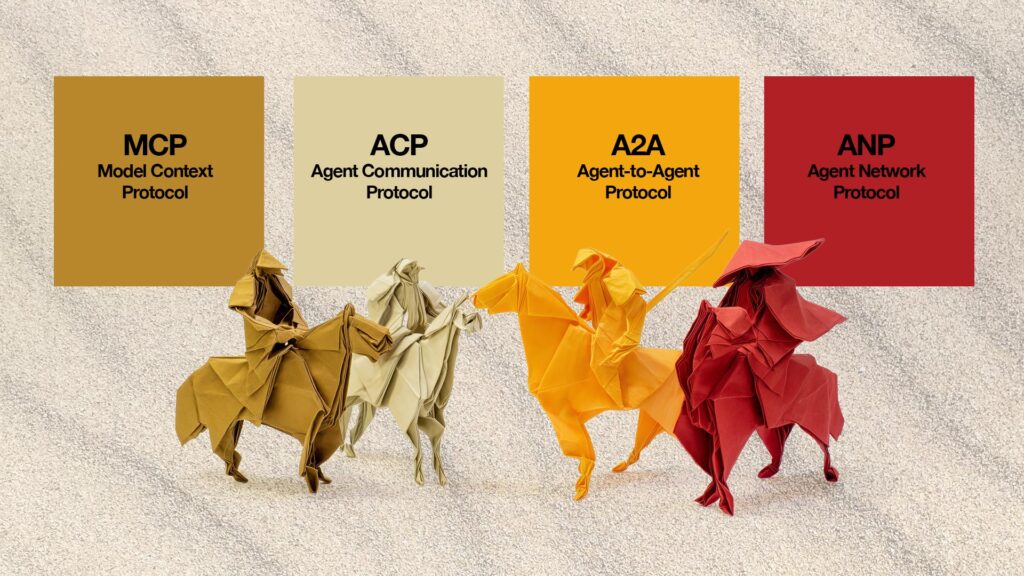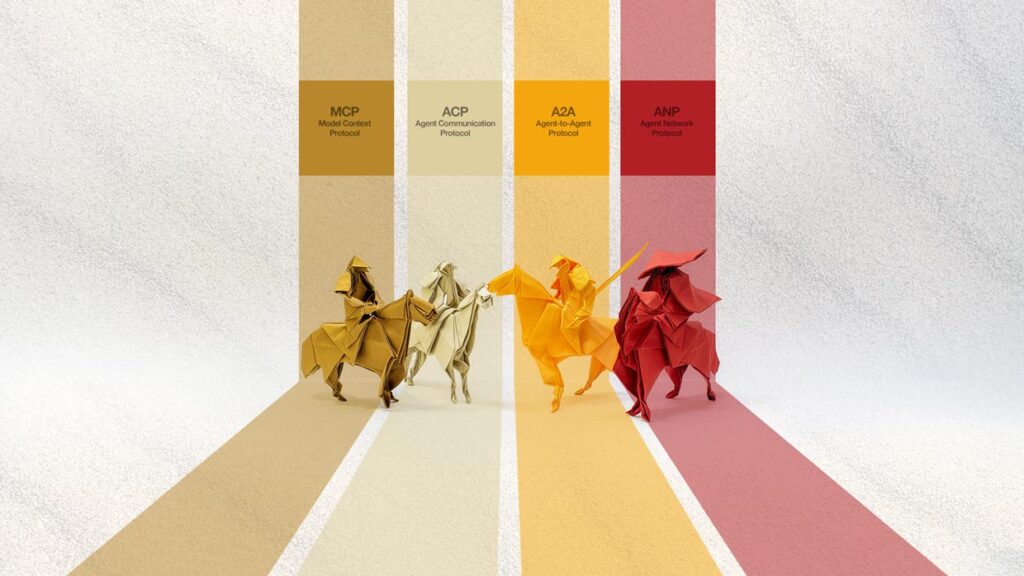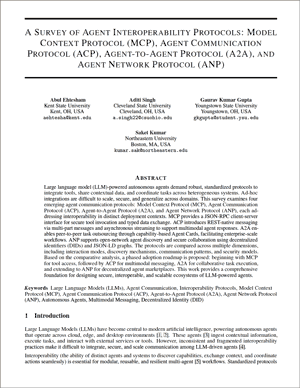MCP, ACP, A2A, and ANP.These protocols aren’t just academic – they’re the blueprint for real-world, scalable, and secure AI ecosystems.
Earlier this week (05.14.25), I had the good fortune of attending the NANDA Summit hosted by MIT’s Media Lab, a forward-looking initiative on building a trust layer for the Internet of AI Agents. The conversations were sharp, current, and deeply relevant to anyone working on AI infrastructure or growth.

A tremendous opportunity to hear directly from those leading the charge like Ramesh Raskar(MIT media lab), John Roese (CTO, Dell) and Todd Segal (A2A, Google), and many others whose teams are helping define how agents communicate, delegate, and earn trust in autonomous systems.
It was at this summit that I encountered a new paper that distills the current state of agent interoperability into four leading protocols: MCP, ACP, A2A, and ANP.
These protocols aren’t just academic – they’re the blueprint for real-world, scalable, and secure AI ecosystems.

Everything You Ever Wanted to Know About Agent Protocols*
* But Were Afraid to Ask
If you’re building AI systems that rely on agents talking to each other – or to tools, services, and other networks – you’re going to run into one unavoidable truth: interoperability is the battlefield. And that means protocols. MCP, ACP, A2A, ANP – these aren’t just acronyms. They’re the wiring behind everything we’re starting to call “agentic.”
Start with MCP if you want stability. Graduate to ACP for flexibility. Go A2A for teamwork. And keep your eyes on ANP if you’re thinking long-game.

This post breaks down the four major protocols that matter, in plain English: what they do, where they fit, and why one size definitely doesn’t fit all. No fluff, no hype – just a clear look at what’s out there and how to choose what to build on. Whether you’re wiring up local agents to hit APIs, coordinating large-scale tasks inside an enterprise, or dreaming about open agent marketplaces – there’s a protocol for that.
From Manual to Autonomous: The New Protocols of Financial Marketing
MCP, ACP, A2A, and ANP form the protocol layer that lets financial marketing strategies operate with speed, precision, and built-in compliance – without adding operational drag.
For CMOs, this means scalable coordination: intelligent agents that manage offer logic, messaging, and regulatory requirements across channels and partners, in real time.
You define the strategy – these protocols make it actionable, adaptive, and accountable.
Wiring Up Local Agents to APIs
Agents embedded in enterprise systems (or even personal devices) can be wired to internal APIs – CRM, core banking, MarTech stacks – to autonomously trigger actions, pull insights, and drive campaign execution without manual workflows.
Example: A lead-scoring agent taps into Salesforce and Marqeta APIs to dynamically adjust offer eligibility and funding logic based on user intent signals.
Coordinating Enterprise-Scale Campaigns
With these protocols, financial marketers can coordinate campaigns across teams, brands, and even regulatory bodies, using intelligent agents that comply with policy, auditability, and personalization at scale.
Outcome: Fully-automated omnichannel campaigns that adapt in real-time to customer behavior, regulations, and market conditions.
Open Agent Marketplaces: The FinTech Frontier
Picture a decentralized marketing ecosystem where your promotional agents shop for ad slots, bid on lead data, or subscribe to customer insights – all autonomously, transparently, and with built-in compliance.
Imagine: Your lending agent discovers a risk-model-as-a-service in an open marketplace, contracts with it, and begins optimizing your campaign’s approval funnel – all without a single developer involved.
Bottom Line:
These four protocols aren’t just technical tools – they’re the foundation of intelligent, autonomous finance. They allow agents to act on behalf of financial institutions, customers, and marketers alike – driving personalization, compliance, and performance at a scale no human team can match.
MCP, ACP, A2A, and ANP The Four Horsemen of the Protocols.
We have assembled a concise technical explanation of each protocol, followed by a simplified comparison table ranking them from most stable/general-use to most emerging.
MCP – Model Context Protocol
MCP is designed as a tightly structured, JSON-RPC-based client-server protocol that standardizes how large language models (LLMs) receive context and interact with external tools.
Think of it as the AI equivalent of USB-C: a unified plug-and-play standard for delivering prompts, resources, tools, and sampling instructions to models. It supports robust session lifecycles (initialize, operate, shut down), secure communication, and asynchronous notifications. It excels in environments where deterministic, typed data flows are essential – like plug-in platforms or enterprise tools with strict integration requirements. Its predictability and strong structure make it the go-to protocol for stable, general-purpose AI agent interactions today.
ACP – Agent Communication Protocol
ACP introduces REST-native, performative messaging using multipart messages, MIME types, and streaming capabilities. This protocol is best suited for systems that already speak HTTP and need richer communication models (text, images, binary data). It sits one layer above MCP – more flexible, more expressive, and excellent for multimodal or asynchronous workflows.
ACP allows agents to communicate through ordered message parts and typed artifacts, making it a better fit for web-native infrastructure and cloud-based multi-agent systems. However, it requires a registry and stronger orchestration overhead, which can introduce complexity.
A2A – Agent-to-Agent Protocol
Developed with enterprise collaboration in mind, A2A allows agents to dynamically discover each other and delegate tasks using structured Agent Cards. These cards describe each agent’s capabilities and authentication needs.
A2A supports both synchronous and asynchronous workflows through JSON-RPC and Server-Sent Events, making it ideal for internal task routing and coordination across teams of agents. It’s powerful in trusted networks and enterprise settings, A2A assumes a relatively static or known network of peers. It doesn’t scale easily to open environments without added infrastructure.
ANP – Agent Network Protocol
ANP is the most decentralized and future-leaning of the protocols. It relies on Decentralized Identifiers (DIDs), semantic web principles (JSON-LD), and open discovery mechanisms to create a peer-to-peer network of interoperable agents. The Agents describe themselves using metadata (ADP files), enabling flexible negotiation and interaction across unknown or untrusted domains.
ANP is foundational for agent marketplaces, cross-platform ecosystems, and long-term visions of the “Internet of AI Agents.” Its trade-off is stability – it’s complex, requires DID infrastructure, and is still maturing in practice.
Most Open and Accessible Protocols (Ranked)
| Rank | Protocol | Stability | Key Characteristics |
|---|---|---|---|
| 1 | MCP | Most stable | JSON-RPC, deterministic tool access, tightly scoped |
| 2 | ACP | High stability | REST-native, multimodal messages, good for web systems |
| 3 | A2A | Medium | Enterprise task routing, Agent Cards, internal networks |
| 4 | ANP | Emerging | Decentralized, peer-to-peer, DIDs, future-focused |
What’s a DID?! A Decentralized Identifier (DID) is a new type of digital identifier that is user-controlled, self-sovereign, and verifiable through cryptography, operating without reliance on any central authority or intermediary.

Metaphor: The Enterprise Office
How the 4 Protocols Interact
When we talk about AI agents and protocols, it’s easy to get lost in jargon – JSON-RPC, DIDs, multipart messages. But if you strip it all down, what we’re really building is organizational behavior, similar to the IRL enterprise office: how smart systems talk to each other, share context, delegate tasks, and connect beyond the firewall.

Picture your company as a classic enterprise office building. People, departments, tools, workflows. Now imagine we’re embedding AI agents into that environment – some helping you internally, others reaching outside. The four major protocols – MCP, ACP, A2A, and ANP – each have a role in making that machine run.
Here’s how they work together, using the structure of a modern office to map it all out.
- MCP is the internal phone system. It lets employees (LLMs) call specific departments (tools) to request information or get a task done. It’s precise, secure, and fast – perfect when you already know who does what. No outside lines, just clean internal calls.
- ACP is your email and messaging platform. People send messages, attachments, updates, and files back and forth, sometimes in real time, sometimes not. It’s flexible and works across teams – even those who don’t use the same apps – as long as they all agree on format and language.
- A2A is the company intranet with smart assistants (agents) embedded in every department. Instead of sending an email or making a call, you drop a request into your local agent, and it finds the right person (or agent) elsewhere to take action. You don’t have to know who does what – it figures that out and gets the job done.
- ANP is the front lobby where external contractors, partners, and vendors come in. But instead of swiping a badge, they identify themselves with cryptographically signed IDs (DIDs), check in with a self-service kiosk (Agent Description), and negotiate access dynamically. It’s open, secure, and built for a future where not everyone works in your building.
In short:
- MCP helps the agents work with tools.
- ACP helps them talk to each other.
- A2A helps them collaborate internally.
- ANP helps them connect externally.
Used together, these protocols turn your office from a collection of disconnected departments into a well-orchestrated, future-ready enterprise.

Why does this matter to a CEO?
Interoperability protocols are not just technical choices – they’re strategic decisions that determine whether your AI investments scale or stall.
Without standardized protocols, your AI agents become siloed tools: expensive, brittle, and unable to coordinate across platforms, teams, or partners. Every new integration becomes a custom build, with mounting costs and unpredictable security exposure.
Protocols like MCP, ACP, A2A, and ANP define how agents connect, share context, and execute across environments – from internal apps to global marketplaces. The right protocol strategy turns isolated AI functions into scalable systems. It reduces integration overhead, protects against vendor lock-in, and positions your organization to participate in larger, more open ecosystems.
In plain terms:
- MCP gives you stable, secure tool access – ideal for internal control.
- ACP opens the door to richer, more flexible agent interactions.
- A2A allows your agents to collaborate and delegate across departments or partners.
- ANP sets you up for future markets where agents transact and negotiate in open environments.
Get this right, and your AI strategy doesn’t just keep pace, it sets the pace.

Elevator Pitch: Piloting AI in a Legacy Enterprise Using Agent Protocols
Most legacy enterprises don’t need to “rip and replace” to get AI working, in many cases they need a controlled, modular way to plug AI into what already works.
Use four agent protocols – MCP, ACP, A2A, and ANP – as a phased architecture to do just that.
- Start with MCP to safely connect your AI agents to internal tools, APIs, and datasets. No surprises, just structured, secure interactions. Think of it as AI accessing your backend – without refactoring it.
- Layer in ACP to enable richer, asynchronous, multimodal messaging between agents and systems. Perfect for integrating agents with your web stack, dashboards, or notification systems – without breaking the frontend.
- Add A2A when you’re ready to delegate tasks across business units – marketing agents talking to finance agents, HR bots syncing with IT systems. This unlocks true automation and collaboration inside the firewall.
- Deploy ANP selectively to connect with trusted partners, vendors, or regulators over open protocols. It’s the gateway to future interoperability – without giving up control.
Together, this stack creates a low-risk, high-leverage pilot: AI agents that work with legacy systems today, and scale into open ecosystems.

Viktor’s thoughts…
You want agents that work in the wild? Pick your poison:
- MCP: Rock solid. Plug-and-play for deterministic model ops. Clean, typed JSON-RPC. Think USB-C for AI – if your system is allergic to surprises, this is your safe bet. But don’t pretend it scales across dynamic teams or shifting workflows.
- ACP: REST-native and loose enough to break a toe on. Supports multimodal, streaming, MIME-packed madness. Excellent if your infra speaks HTTP – but say goodbye to simplicity. This is where the orchestration demons start showing up.
- A2A: Agent-to-agent delegation for enterprise control freaks. Agent Cards, structured discovery, secure channels. But it’s brittle as hell in untrusted environments and smells like middleware if you squint too hard.
- ANP: The sexy one. Decentralized. DID-based. Web3-adjacent. Built for trustless peer-to-peer agent economies. Except it’s undercooked, overhyped, and five minutes from imploding if someone sneezes on the JSON-LD schema.
You think you’re building scalable AI systems? Without understanding these four, you’re playing with dollhouses and calling it architecture. The whole game is context-sharing and task delegation across boundaries. And these are the pipes – flawed, evolving, but currently all we’ve got.
Let’s map it in terms anyone who’s suffered through corporate life can understand:
- MCP: The direct phone line. Internal, reliable, dumb but fast.
- ACP: The company Slack. Multimedia chaos that occasionally works.
- A2A: The overengineered SharePoint replacement that almost routes requests properly.
- ANP: The crypto-secure guest kiosk that can’t decide if it’s a lobby or a border crossing.
This is not “future of work” fluff. This is the beginning of protocol warfare. The winners won’t be the ones who built the prettiest agents. They’ll be the ones who figured out how to make them talk.
So What Should a CEO Care About?
Because if your agents can’t connect, they can’t collaborate. And if they can’t collaborate, you’re stuck duct-taping $10 million worth of AI pilots into a system that’ll collapse the minute you try to scale. MCP is safe. ACP is flexible. A2A is structured delegation. ANP is your long shot at market access.
Pick wrong, and you’re building an empire of silos.
Pick right, and your AI stack becomes a network – modular, distributed, secure, and ready for real-world autonomy.
Who is Viktor?
A full-throttle persona with the tools to back it up. Viktor is no mere figurehead – he’s the force that demands excellence through absolute scrutiny. If you want your team to evolve, you throw VIKTOR in the mix. If not, you’re stuck with mediocrity. Let’s be clear: Viktor’s not your typical “Black Hat” in the hacking sense. He’s the personification of cold, calculated skepticism, driven by results. He forces you to prove your ideas, not just show them off like flashy toys.
He is an invaluable team member especially when it comes to reviewing and commenting on posts related to tech and innovation. All comments are his own.
Name: Viktor
Role: The Relentless Skeptic
Tagline: If it doesn’t survive scrutiny, it doesn’t deserve air time.
SOURCE:

Survey of Agent Interoperability
May 4, 2025